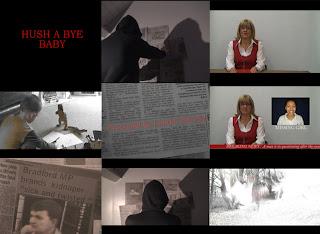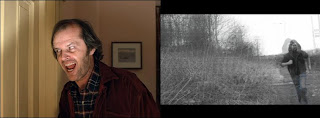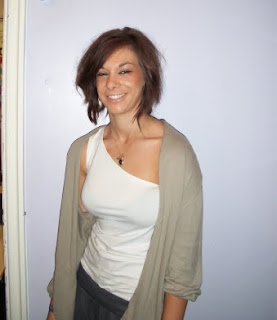Tuesday, 4 May 2010
In what ways does your media products use, develop or challenge forms and conventions of real media products?
 Title sequence
Title sequenceThe title of our film is displayed in the first frame. It is produced on a plain black background with bold text in red. The contrast of these colours helps the title to stand out and in addition the colours red and black are reflected with the genre of a Thriller.
Our original idea was to print stories and headlines off the computer and stick then to newspapers hung up on the wall. Although when we first did this, it didn’t look professional and we thought once in black and white you wouldn’t be able to tell that we had printed them out ourselves.
However we were wrong, the quality was just as bad and it set a low standard for the rest of the film. For this reason we decided to edit newspapers on Photoshop and then get them printed A3 size. This looked much more professional and well worth filming again.
This idea of the newspaper cuts outs came when doing research into other crime thriller movies.
Setting/Location
The reason why I have chosen the small box room as my setting/location shot is because I felt it reflected the conventions of a Thriller best. By using this small box room as where the kidnapper was located it created an eerie atmosphere and is also recognisable to the audience in understanding not only the genre but also in understanding the storyline.
Costumes and Props
Every film has costumes and props, within this frame you can see I have chosen the shot of the news reporter. The props used within this are the desk and chair she is sat at to make the shot look professional and recognisable as a news programme. In addition she is dressed smartly as it would be broadcasted to thousands of people.
Our title sequence, like many other films rely on the props and costumes to outline each different character and show distinctive scenes.
Camerawork and editing
When looking at real media products of a Crime Thriller movie, for example, Feardotcom, I found that the camera work used was also used in most of the other media products. From watching some real media products I was able to follow the conventions as closely as possible and use them to create atmosphere in our opening sequence.
The media products most popular camera angles were, Close Ups, Long Shots, and Extreme Long Shots. As a result I was able to develop on these in our media product to achieve the best possible result of a Crime Thriller and at the same time follow the conventions.
Flashbacks where an idea taken from the film ‘Se7en’ which uses the types of fast editing we have used to show the past and present and also using an eerie overlapping effect on them scenes helped follow the conventions of the genre. We thought that by using unusual editing it would help the audience understand what we are trying to represent and also make it more interesting to watch.
Title/Font and Style
This frame is from the part of the title sequence where we used the newspaper cutting to represent what roles we each took on, ‘Produced by Lauren Hartley’.
The font used is Sans Serif as we just wanted to keep it normal and not use a fancy looking font as it wouldn’t fit with the genre of a Thriller.
By using newspaper cuttings for the title sequence it flowed with the genre of the opening sequence (Crime Thriller).
When panning the shit to the next role, the text would light up to the same colour that is used for the film title. the colour red is used as we felt it was a connotation of death.
Story and how the opening sets up
The opening sequence starts off with a news reporter who describes an overview of what has actually happened already within ‘Hush a Bye Baby’.
However we did challenge the conventions by using the script to explain what has happened in the opening sequence. Most of the media products I watched didn’t use scripting but we felt the script in our opening sequence would make it easier to understand, like what Oceans 13 does, which is also a Crime Thriller.
However we use a lot more speech compared to Oceans 13 as we felt our opening sequence was alot harder to understand.
As well as the story been set up through the new reporter, we start to understand what has happened more with a shot of the kidnapper looking at the newspaper cuttings on the wall, the camera then zooms into his head and the is then represented through flashbacks.
Genre and how the opening suggests it
In this frame I have chosen to display the newspaper cutting which are placed upon the wall of the small room that the kidnapper is in. These newspapers are different stories of the crimes the he has committed.
By using newspaper cuttings of different crimes that have taken place it helps the audience recognise a Crime Thriller and in addition the opening sequence is like a guessing game of what will happen during the rest of the film.
How characters are introduced
The main character, ‘the kidnapper’ is introduced within the opening sequence and in addition so is are the children who have gone missing. To follow the conventions of a real media production (Crime Thriller) I developed upon the idea of introducing the main characters to the audience which help them to develop an idea of what will happen within the rest of the film. Conventions of an opening sequence sugget only a small number of main characters and locations should be introduced to help with the understanding of the opening sequence.
Special effects
Within our media production of a Thriller we used special effects to create atmosphere because of our genre. The effects were mainly used within the flashbacks here was fast editing and transitions from one flashback to another. The type of effect we used was a montage which flowed one shot into another. We also used special effects which picked a certain colour out of the scene, for example the colour of the children’s toys/kidnapper's jeans.
Overall I feel that generally we followed the forms and conventions of other real media products with the smae genre as ours, however i do feel our opening sequence is different due to our original ideas and inputs we all had, for example using a script.
How does your media product represent particular social groups?

We decided to cast an older male to be the kidnapper. This would help the film broaden its appeal to a range of audiences. The actor we casted as the kidnapper also had an interest in drama and had experience in the field and therefore was passionate about what he was doing.
We felt the role of the kidnapper should be a very depressed young man who felt alone. When thinking of which particular social group our media product would represent, a character from another film with similarities to the kidnapper was Jack Nicholson in The Shining.
They both seem to be very upset, aggressive and depressed characters and both endure in disturbing behaviour. However the character we have used in our media product is a lot younger than the character in The Shining and what they both do it very different. Our character doesn’t seem to have any family whereas Jack Nicholson is with his family. They do both however wear very scruffy clothing and don’t look like they have washed in along time
What kind of media institutions might distribute your media product and why?
A production company creates ideas and motion pictures, TV programmes, and adverts etc - they may also find funding for the products they produce. Warner bros have produced, Oceans 11, Feardotcom and The Dark Knight which all follow similar genres to our final production piece.
A distributor is someone reliable who would get the film out there and support it fully. Paramount Pictures would be the most reliable - they've been going for years and have already got films being produced for 2013.
There are film finance entities like banks that the Hollywood studios regularly borrow from as well as finance entities who offer a piece of the action to investors in the form of mutual funds.
When a mid-level producer seeks funding, they sometimes approach banks or investors especially if they have significant "attachments" (big name actors, etc.)
Lower level projects sometimes are financed by a producer and/or director of the film in part with other investors, or independently.
A producer budgets the movie based upon prior films of similar scale, the needs of the director, the known negotiated fees for actors, etc.
Various people are named within the title sequence of our Thriller Movie, these include the roles we took on as a group including, Director, Producer, Artistic Director and Chief Editor.
Our film is similar institutionally to Oceans 11 as a Crime Thriller and Se7en as an actually Thriller.
When looking at the SBBFC guidelines of how to rate films I found that if we had carried on filming the product it would be rated a 15 because of the strong gory images and strong threat and menace which are unlikely to be acceptable at a lower rating.
When researching films in the cinema the most popular rated films were rated at a 12 and then were sold later on DVD’s as a 15. To attract a bigger audience we would have to cut down parts of the film which had strong language and violence to reach a rating of 12 but then re-include these scenes when released on DVD.
The film would be advertised on the side of buses, which would attract a large audience from all over and on TV, which would consist of a trailer about the film, and would also be sold as a DVD when released after been in the cinemas for a period of time, which would help achieve a bigger target audience.
To get the companies to premier our media product however we would have to sell it to them and would have to persuade them to buy it from us.
Who would be the audience for your media product?
 Part of my role was to send out a Questionnaire as research into the audience we would be creating the film for and what type of film they would enjoy. After sending out the questionnaire I collected all the results together and placed them in charts to find out who our audience would be.
Part of my role was to send out a Questionnaire as research into the audience we would be creating the film for and what type of film they would enjoy. After sending out the questionnaire I collected all the results together and placed them in charts to find out who our audience would be.Looking back at the results there was a range of age ratings, but the most popular rating was 15 which we had already decided would be the best audience.Therefore creating summaries of films for our research I looked at films that were rated 15 so I could concentrate on the conventions that our film would follow and be able to create a storyline that would fit our audience.
Our audience doesn’t specifically target males or females as we felt that both genders of the same ages would enjoy watching a Thriller movie.
What have you learnt about technologies from the process of constructing this product?
By using the tripod I was able to make sure that the camera was still which made the whole product look a lot more professional and also when creating a panning shot I was able to use a dolly (a type of tripod) which helped make the transition much more steady and smooth. I used three different types of tripods to create each different camera shot used. With the panning shots I used a dolly, with the normal closes ups, longs shots and extreme longs shots I used a standard tripod but with the close up of the newspaper falling to the grounds I used a miniature tripod which made it easier to film the angle so close to the ground.

Premier Elements was the editing software we used. The editing aspects of what we have learnt about technologies for constructing our product are, firstly, the fact that the different parts must be edited together in such a way that it has a good continuity together – flows nicely from shot to shot. We also learnt that sometimes technology can let you down as sometimes computers can be unpredictable and freeze or errors can occur which caused the editing aspect to be very time consuming.

The sound within the product is key. To get the product right we had to re record the news reporting sound as it was too quiet, so we have to make sure the actor speaks loud enough or the microphone is closer. The microphone is important as it enables to get a clear sound as the camcorder doesn’t always pick everything up especially if the shot is from a distance.
